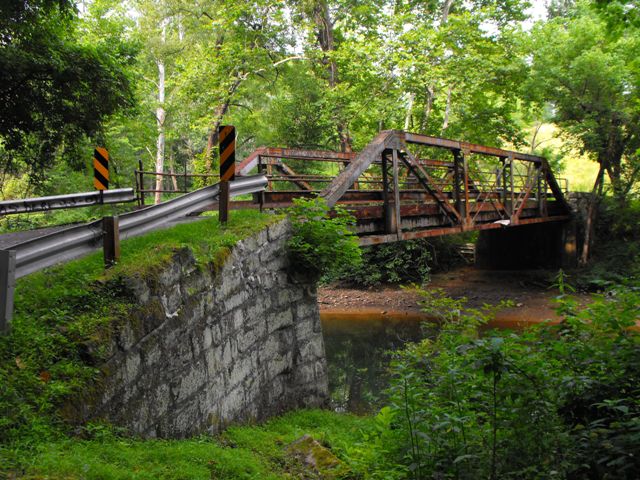We Recommend:
Bach Steel - Experts at historic truss bridge restoration.
BridgeHunter.com Phase 1 is released to the public! - Visit Now
Gans Hill School Road Bridge
Urbania Road Bridge

Primary Photographer(s): Nathan Holth and Rick McOmber
Bridge Documented: July 12, 2009
Gans Hill School Road (Urbania Road - TR-335) Over Georges Creek
Rural: Fayette County, Pennsylvania: United States
Not Available or Not Applicable
75.0 Feet (22.9 Meters)
78.0 Feet (23.8 Meters)
10.8 Feet (3.29 Meters)
1 Main Span(s)
26722003351091

View Information About HSR Ratings
Bridge Documentation
View Archived National Bridge Inventory Report - Has Additional Details and Evaluation
This five panel pony truss bridge is in general a traditionally composed metal truss bridge, but it has unusual details which make it noteworthy. It is however noteworthy for having a composite deck that includes a concrete structural base topped with a brick wearing surface. Brick decks on bridges are extremely rare, but are a visually beautiful form of deck. In addition, provided that the concrete base retains structural integrity, the brick wearing surface will last a very long time. In the case of this bridge however, the deck is the one thing on this bridge in need of repair. The entire bridge is rated by the National Bridge Inventory as Fair, except for the deck which is rated as Serious. As a result, a good preservation solution for this bridge would be to carefully remove the bricks, replace the concrete deck base, and place the bricks back on the bridge.
One of the most unusual features of this bridge is that in the center panels there are turnbuckles. This is highly unusual for a bridge of this type since it does not make sense on a truss bridge with riveted connections. Rivet-connected truss bridges are a rigid truss form and do not usually require any adjustment of tension, and as a result most truss bridges do not have them. The only explicable reason for the turnbuckles is that the builder must have thought that perhaps over time the diagonals (tension members) would stretch enough over time that even on a rigid truss bridge they might still need to be tightened.
The noteworthy details on this bridge coupled with its very rural location that sees hardly any traffic make it a good candidate for preservation for continued vehicular use.
This is a post-1900 riveted truss bridge. The Pennsylvania Historic Bridge Inventory dismissed the vast majority of post-1900 riveted truss bridges as not historic and not eligible for the National Register of Historic Places, regardless of integrity, size, or construction date. The Pennsylvania historic bridge inventory operates on the philosophy that historic significant arises only from innovative, prototypical engineering, and that significance does not arise from good representative examples of structures from a period in history. This appears to go against the philosophy of the National Register of Historic Places which has accepted structures from both categories in other states. However, the Gans Hill Road Bridge does have an innovative and distinctive detail: the unusual turnbuckles on the center panel diagonals. In addition, the brick deck is extremely rare and noteworthy as an example of a different approach to bridge decks than the standard wood or plain concrete used during the period. This bridge should be considered eligible as a result. The information below from the Historic Bridge Inventory is provided for structure information and reference only. HistoricBridges.org does not agree with the findings of the below historic bridge inventory assessment.
Information and Findings From Pennsylvania's Historic Bridge InventoryDiscussion of Bridge The 5 panel, 77' long and 12' wide, riveted Pratt pony truss built in 1909 is supported on ashlar abutments with wingwalls. The trusses are traditionally composed with the upper chords and end posts being angles with cover plate. The lower chords, diagonals, and verticals are angles with battens or lacing. The concrete deck has a brick wearing surface, and two-high pipe railings are inside the truss lines. The bridge is an example of the light standardized design that was fabricated by many companies. Neither the bridge, with no innovative or distinctive details, nor its setting are historically or technologically significant. The bridge is one of over 12 early-20th century pony truss bridges in the county. Discussion of Surrounding Area The bridge carries 1 lane of an unimproved township road over a stream in a sparsely developed, wooded setting. Bridge Considered Historic By Survey: No |
![]()
Photo Galleries and Videos: Gans Hill School Road Bridge
Bridge Photo-Documentation
Original / Full Size PhotosA collection of overview and detail photos. This gallery offers photos in the highest available resolution and file size in a touch-friendly popup viewer.
Alternatively, Browse Without Using Viewer
![]()
Bridge Photo-Documentation
Mobile Optimized PhotosA collection of overview and detail photos. This gallery features data-friendly, fast-loading photos in a touch-friendly popup viewer.
Alternatively, Browse Without Using Viewer
![]()
Maps and Links: Gans Hill School Road Bridge
Coordinates (Latitude, Longitude):
Search For Additional Bridge Listings:
Bridgehunter.com: View listed bridges within 0.5 miles (0.8 kilometers) of this bridge.
Bridgehunter.com: View listed bridges within 10 miles (16 kilometers) of this bridge.
Additional Maps:
Google Streetview (If Available)
GeoHack (Additional Links and Coordinates)
Apple Maps (Via DuckDuckGo Search)
Apple Maps (Apple devices only)
Android: Open Location In Your Map or GPS App
Flickr Gallery (Find Nearby Photos)
Wikimedia Commons (Find Nearby Photos)
Directions Via Sygic For Android
Directions Via Sygic For iOS and Android Dolphin Browser
USGS National Map (United States Only)
Historical USGS Topo Maps (United States Only)
Historic Aerials (United States Only)
CalTopo Maps (United States Only)

